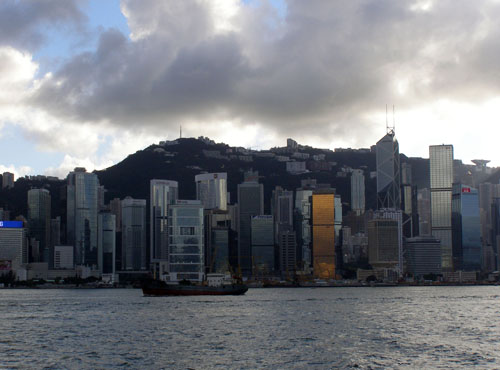Shopping malls are becoming a China real estate hot spot as government efforts to ease housing prices reduce interest among developers in building apartment complexes.
So says Adam Mayer, a USC-educated senior project architect based in the western Chinese city of Chengdu for Cendes, a Singapore-founded architecture firm with projects in more than 20 Chinese cities. Rapid growth in Chinese retail spending, he says, “represents a shift of the Chinese economy from one of production to a more domestic, consumer-oriented market.”
I talked to Mayer on the sidelines of a conference about the business outlook in central China held yesterday in Luoyang, one of China’s ancient hubs. The event was being organized by Forbes China, the licensed Chinese-language edition of Forbes magazine, and the city government, and attracted speakers from IBM and GE. Excerpts follow.
Q. China’s government seems to be slowing down the pace of the real estate industry right now. To what extent do you feel any of that in your own company?
A. We do see it in the sense that there’s a shift away from such rapid development of residential property. Not all residential types, though, just, specifically, the high-rise clustered residential you see in all cities across China. The shift is more toward villas, which in the U.S. we would call detached houses. These are not intended to be primary residences. Rather, they are intended and marketed towards wealthy individuals who want a second home or a vacation home that’s outside the city.
What we’re seeing now is a huge growth in the retail sector in the design and developments of shopping malls, especially in Chengdu where we have a lot of work, and also in Kunming, the capital of Yunnan Province. We’ve been seeing a lot of mixed-used developments in the planning phases now. These are typically 4-5 storey retail shopping malls (that) in architectural terms we call a podium. These are usually high density sites. They have high floor to area ratios, which are zoning numbers that tell you how much square meters you can build on that site. These are usually in center city areas, and also around the second or third ring roads that are developing out from the center, typically around transit hubs where there might be a subway station. There are retail podiums with office towers, or it could be a hotel tower and also some residential tower on top.
Q. What’s driving that investment?
A. I think it’s really more about retail. The developers are maximizing the FAR (floor to area ratio), and that’s why they’re building towers on top, but the retail really represents a shift of the Chinese economy from one of production to a more domestic, consumer oriented market. So we see real estate developers really pushing hard (on) the retail development.
Q. In the old days, Chinese developers were making plenty of money just by building those tall residential buildings and selling them out quickly. Now, those same builders appear to be increasingly interested in commercial property. Do you see signs of that?
A. For sure. If developers are only in the residential sector, they definitely need to diversify. Also, when it comes to geographical development, (there’s a) shift of development of China moving from the coast inward (and) west. We see that happening to even further west than Chengdu, and, if you can imagine, into Urumqi and Xinjiang Province.
Forbes: Shopping Malls Become China Real Estate Hot Spot As Economy Shifts






by Adam Mayer
Chinesecrash - I tend to disagree with the above and think it is simply PR to cover over the cracks.
Fact is “China’s economy is heading for an imminent and disastrous crash due to its inflated housing market” just a matter of when rather than if…..
Check out any of the following articles and see why:
http://www.chinesecrash.com
Adam Nathaniel Mayer - Thanks for your message, Chinesecrash. I checked out your website and I happen to think that you might be a bit paranoid about the threat of a property bubble in China.
Let me first say that no one is trying to hide the fact that housing prices in many cities are way above the threshold of affordability for middle-class Chinese urban dwellers. There is no ‘PR’ conspiracy trying to cover this reality up. Even top leaders in the Chinese Central Government acknowledge this is a big problem and are enacting measures to curb real estate speculation.
That being said, stopping the construction of new housing units in China at this point in time would only exacerbate the problem of housing affordability by limiting supply. Not to mention, it would put a lot of people out of work, something the Chinese government is very concerned about because of the threat of social instability.
What I foresee happening (and is already happening to some extent) is a gradual shift away from housing development into other types of real estate such as commercial, retail and cultural buildings. We also see the Chinese economy at a macro level starting to evolve from one reliant on low-end manufacturing and infrastructure development to one focused more on high-end manufacturing, R&D and the service industry.
China has tremendous challenges ahead, but if the past 30 years is any indication, it is very unlikely that the country is headed for a devastating crash anytime soon.
Chinesecrash - Hi Nathan,
While I take your point, I would tend to disagree and go as far to say the residential property bubble will burst in China in the next 9-12 months.
Why?
– Chinese banks have now stopped lending to developers
– Developers are severely squeezed and cannot get credit and seeking it on international markets or forced to sell at low prices
– Oversupply of units will be dumped on market at low prices and will be glut forcing all prices downwards
– The govt has now done all it can to cool the property market
– Interest rates are rising and inflation rising
This is a perfect storm for the Chinese Property Market
For more read http://www.chinesecrash.com/1/post/2011/06/chinesecrash-china-property-bubble-will-burst-in-the-next-9-12-months.html
Charlie - Great post Adam, this is something I’ve been thinking about for a while. Can China manage this rate of growth or is building beyond demand compounding the already numerous concerns about property and equity?
Steve Dickinson spoke about this and related topics at length recently in Chengdu, which I covered in a recent post on Chengdu Living. I’d love to hear what you think about his analysis. Here’s a link to the post: http://www.chengduliving.com/interview-with-china-law-blog/
Also sprach Analyst - I think there has been little doubt even among optimists that there are bubbles in some forms or another. The biggest threat right now, to me, is the fact that most people are still confident that the Chinese government is able to engineer a soft-landing and change its economic growth model away from investment. In the event that the Chinese government fails, that would surprise and shock many people.
My view is that people are over-estimating Chinese government’s ability in delivering necessary changes to the economy, falsely believing that the Chinese economy is really a command economy and government has great control over it. In short, that’s the “this time is different” syndrome. Also, most are focusing on the trend in the past decades of urbanisation that creates demand for real estate, while completely ignoring the negative impact of population ageing on real estate prices, which was really one of the driving forces for the 20-year bear market for Japanese real estate.
Whether the economy will crash disastrously, I know not. But I strongly believe that one should not be surprised by any slowdown, and one should be prepared for a crash-landing scenario as far as their investment strategies are concerned, instead of trying to argue that there are no problems with high real estate prices, etc. The reason that one should be prepared for that is that even if a crash-landing for Chinese economy is a low probability event, the impact will be very huge.